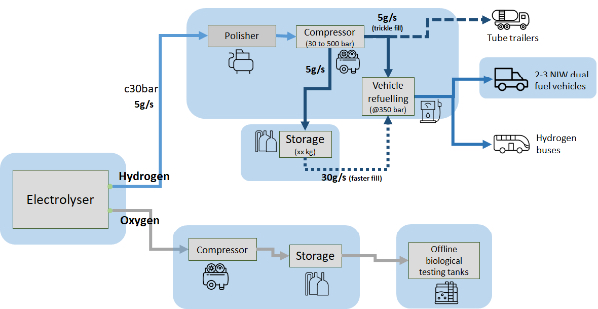Situation
The next phase of decarbonising Northern Ireland’s electricity system will require greater flexibility in how and when we consume and produce energy as well as a substantial increase in storing energy when it is plentiful so that it can subsequently be used when it’s needed.
Wind generation will dominate yet the proportion of the time that turbines are switched off is increasing. This can happen on a windy day when supply exceeds demand but most commonly at night when electricity demand is low. Already over 15% of generating capacity is being wasted.
Electrolysis is a way of making use of wasted generating capacity. It splits water into hydrogen (H2) which is an energy that can be stored. When produced from renewable electricity, Green Hydrogen is now recognised as providing energy for larger buses and HGVs.
Electrolysis produces oxygen which is vented (wasted) to atmosphere. Augmenting the aeration process in wastewater (WW) treatment with oxygen can increase throughput capacity. Over 100 of Northern Ireland’s cities and towns have constrained systems. Using established engineering solutions, it will take 18 years of elevated levels of investment to address the backlog – so limiting commercial and housing developments, thereby adversely impacting the economy.
Action
We can produce Green hydrogen cost effectively by using our existing major grid connections, our land and electricity buying power. We can harness the lower whole life costs obtained from “disruptor” electrolyser technology. We can derive an income from providing flexibility to the electricity system. And we extract a benefit from the use of oxygen.
Based on research and using a small electrolyser, a pilot has been undertaken to assess the benefits of oxygen being used at a WW site. Early results from this pilot are encouraging. These show a 25% increase in processing throughput at the aeration stage with more ideas in development to increase this further.
A world leading project is now underway. It was procured using the OJEU Innovation Partnership Procedure; a firstof-a-kind for NI. Phase one of the 1MW demonstrator at Belfast goes live in early 2022. Results here will significantly increase confidence in the potential of oxygen to address wastewater constraint. The hydrogen, compressed and stored as a transport fuel, offers Northern Ireland’s public transport sector access to affordable local fuel source to assist in decarbonisation.
Beyond the demonstrator, the is potential to deploy at much larger scale across many of our larger wastewater treatment works.

Results
This project demonstrates how integrated development can unlock a series of benefits in the water, electricity, and transport sectors to justify the wide scale deployment of electrolysis. It can be a catalyst to help stimulate NIs hydrogen economy, help decarbonisation NIs electricity system, and potentially help us to do more faster and greener in addressing wastewater capacity constraints.